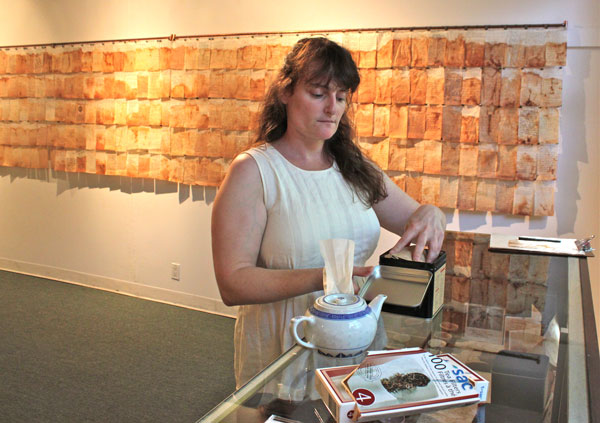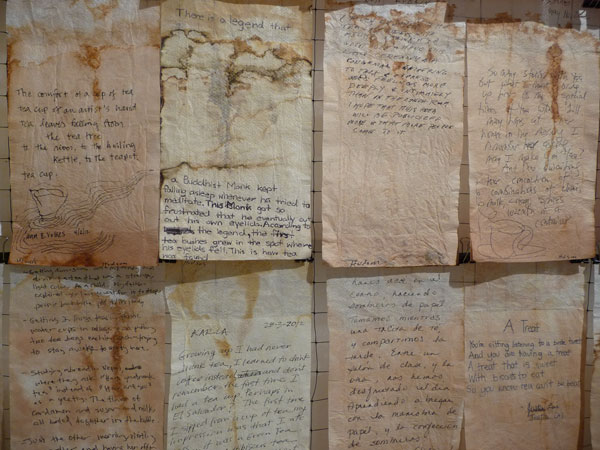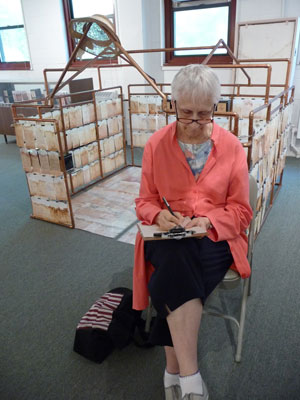
BY BONNIE ROSENSTOCK | Michele Brody’s installation at Hudson Guild’s Gallery II, “Reflections in Tea — stories and poetry on recycled tea bags,” draws on a proverb by the Baltis (an ethnic group of Tibetan descent who live in the northernmost mountainous region of Pakistan), quoted in Greg Mortenson’s “Three Cups of Tea”: “The first time you share tea with a Balti, you are a stranger. The second time, you are an honored guest. The third time you share a cup of tea, you become family.”
To this time-honored notion of family, Brody — the visual artist in residence at the Guild’s senior center — has combined the ritual of preparing and serving tea and spiked it with her own special admixture: repurposing tea-soaked bags as writing paper to stimulate a community share-fest. “What I proposed to do with the tea project was not just interacting with students, but with the whole community, opened up to everybody,” said Brody.
During the first half of her residency (which ends in August), Brody and Brooklyn poet Gary Glazner have collaborated on two CommuniTea with Poetry events in the gallery — where participants served tea to one another and wrote and shared their thoughts, poems and reminiscences of the multi-faceted infusion. These writings and others line the southern and eastern walls like a patchwork quilt — more than 500 contributions from individual and group tea ceremonies she has hosted while at the Guild and other venues.
The aromatic loose leaf teas and elongated German-made “t-sacs” were donated by serendipiTea of Manhasset, Long Island. The sacs are made from abaca, a very strong fiber from the inside of a banana tree. “They can take getting wet and still retain their form,” explained Brody. “I let them dry out and iron them flat, and they become like writing paper.” The resultant seven-inch-long by four-inch-wide surfaces create unique variegated earth-toned stain patterns — reminiscent of the mountain ranges where tea is cultivated, said Brody.
Brody serves the tea in handmade pinch pot teacups (diminutive bowls without handles) made by artists from the Guild’s ceramics studio. Ava McNamee, who teaches ceramics here and at Penn South, was one of the contributing artists. “Michele introduced me to the process of dipping the cup in tea and letting it stay for a while to get stained, which produces a beautiful crackle effect,” said McNamee.
When not in use, the cups share a display case with canisters of tea varieties and Brody’s handmade tea purses, tea books and “Reflections in Tea” catalogue, which are all for sale.
Brody also invites gallery visitors to take tea inside an open structure resembling a Japanese teahouse, which you crouch down to get into and then sit on comfortable mats. The frame is constructed solely of copper pipe, and the stories (attached only at their tops) give the illusion of fluttering walls or mini window shades. “The copper pipe is a beautiful color,” observed Brody. “It goes well with tea, but also represents how liquid runs through the inside of our homes and brings it out into the light of the community.”
Also on exhibit are selections from Brody’s previous solo show, the first installment of her residency, “Drawing Roots” — drawings on handmade paper that she produced by planting flax seeds in recycled linen/flax pulp that sprouted as if planted in soil. As the seedlings grow, their roots migrate below, etching their way into the paper and creating spider-like patterns.
Native New Yorker Brody, 45, a former Chelsea resident now living in Harlem, has been working with tea and material for a long time to “express what I love — the colors, smell, taste, especially the stains — as part of my daily life,” she said.
Brody admitted to drinking all kinds of tea three times a day, all day long, and saving her own tea bags to write on. “I was going through a breakup and writing everything I was feeling. It was very cathartic. It was nothing I wanted to show, but the idea of writing on tea bags intrigued me, treating them like journal pages.”
That evolved into collecting other people’s reflections about tea. At the DUMBO Art Under the Bridge Festival in 2007, she rented a coffee cart and invited people to sit and have tea with her. She has since brought her roving tea ceremony to the Henry Street Settlement, and (in a pushcart) to the Tenement Museum, among other New York cultural institutions.
Brody was influenced by her travels abroad, where she observed tea’s strong links to family, community and tradition. In England, where it’s cold and wet, afternoon tea fortifies. In Japan, the tea ceremony is highly ritualized and studied for years to perfect. In the Middle East, besides tea as hospitality, it is also used as a means of doing business, as anyone who has ever bargained in Morocco can attest.
Tea was first cultivated in China over 4,000 years ago, although today, India has become the largest exporter. The strong, hot brew remains extremely popular in Asia and is steeped in tradition and myths. When Brody was invited to a fifth-grade class in Chinatown on Career Day, one of the Chinese students recounted on his tea bag a well-known legend, learned in childhood:
“A Buddhist monk kept falling asleep when he tried to meditate.
This monk got so frustrated that he eventually cut out his own eyelids.
The first tea bush grew in the spot where his eyelids fell.”
At the Guild, however, the predominantly Hispanic senior population doesn’t have a tea-drinking culture and couldn’t connect with it, said Brody. Many refused to drink tea because it brought up associations with being ill as children and forced to drink medicinal tea; chamomile and ginger are still used as digestives.
Although not all participants were tea lovers, they were still encouraged to express themselves. One woman offered her perspective, in Spanish (translated):
“I always enjoy coffee, but when someone special comes to my house, I always offer them hot tea because I believe it’s the best. I feel very happy to offer tea. It’s so elegant. They return to see me, thanks to my tea.”

A native English-speaking woman, also not a fan, proposed:
“tea?
not for me!
offer me beer
I’ll drink it with
cheer”
Another contributor used the occasion to memorialize a departed friend. She drew a teapot and wrote:
“Tea with Edie
(a lover of teas & teapots)
A memory, a mourning
Tea, then tears…”
When Jim Furlong, the Guild’s director of arts, first saw Brody’s portfolio a couple of years ago, he was impressed with how original her art was and offered her the residency. “She takes these unusual elements — roots, earth, tea bags and stains — and made beautiful, somewhat abstract, art out of it,” he said. “She creates a very magical, other-worldly aura. It’s hard to pin down a category for what she does, and she resists it and persuades me to resist it also.”

Furlong holds his weekly class, “The Lively Arts,” in the gallery, where Brody gave an interactive session with his students. Ellen Wagner is still mulling over what Brody imparted. “I am in the process of writing something on many papers,” she said. Wagner, who also helped out at the June 21 opening reception, is leaning towards writing about Brody, “someone breaking the standard rules for artistic treatment by making canvases of tea bags. I have never seen this before.”
The dark bean forces have supplanted our once-thriving pre-World War II green tea-drinking culture. Just over 100 years ago, the U.S. introduced iced tea to the world at the 1904 World’s Fair in St. Louis. If anyone noticed, June was National Iced Tea Month. According to statistics, more than 40 billion cold cups are consumed annually — impressive for a Starbucks-sucking nation. Hopefully, this exhibit will give tea the pick-me-up it deserves.
“Reflections in Tea — stories and poetry on recycled tea bags” takes place through Aug. 7, at Hudson Guild Fulton Center, Guild Gallery II (119 Ninth Ave., btw. 17th & 18th Sts.). Viewing hours: Wed., Thurs., Fri., 3-6pm and by appointment (contact michele@michelebrody.com). For more information, visit hudsonguild.org.

















